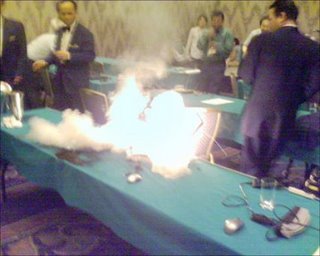Richard Feynman - A Video interview
I wish I had the privilege to sit through one of his lectures, but I was only Five when he passed away. The following video illustrates a brief glimpse of his prolific personality. |
|
Excellent short 40 min documentary interview with Dr. RP Feynman- one of the greatest physicist of our times and a Nobel Laureate. Specially uploaded for students of NSIT.
|
Other videos of Richard Feynman:
Explaining Refraction in waterA Briefing about my Favourite Scientist in Wiki
Richard Phillips Feynman (May 11, 1918 in Queens, New York – February 15, 1988 in Los Angeles, California) was an influential American physicist known for expanding greatly on the theory of quantum electrodynamics, particle theory, and the physics of the superfluidity of supercooled liquid helium. For his work on quantum electrodynamics, Feynman was one of the recipients of the Nobel Prize in Physics in 1965, along with Julian Schwinger and Shin-Ichiro Tomonaga; in this work, he developed a way to understand the behavior of subatomic particles using pictorial tools now called Feynman diagrams.
He helped in the development of the atomic bomb and was later a member of the panel that investigated the Space Shuttle Challenger disaster. For all his prolific contributions, Feynman wrote only 37 research papers in his career. Apart from pure physics, Feynman is also credited with the revolutionary concept and early exploration of quantum computing, and publicly envisioning nanotechnology, the ability to create devices at the molecular scale. He held the Richard Chace Tolman professorship in theoretical physics at Caltech.
Feynman was a keen and influential popularizer of physics in both his books and lectures, notably a seminal 1959 talk on top-down nanotechnology called There's Plenty of Room at the Bottom and The Feynman Lectures on Physics, a three-volume set which has become a classic text. In his lifetime as well as in the years after his death, he became one of the most publicly known scientists of the century. Known for his insatiable curiosity, gentle wit, brilliant mind and playful temperament [1], he is also famous for his many adventures, detailed in the books Surely You're Joking, Mr. Feynman!, What Do You Care What Other People Think? and Tuva or Bust!. As well as being an inspiring lecturer, bongo player, notorious practical joker, and decipherer of Mayan hieroglyphics, Richard Feynman was, in many respects, an eccentric and a free spirit. He liked to pursue many independent paths, such as biology, art, percussion, and lockbreaking. Freeman Dyson once wrote that Feynman was "half-genius, half-buffoon", but later changed this to "all-genius, all-buffoon".
Quotations
"Dear Mrs. Chown, Ignore your son's attempts to teach you physics. Physics isn't the most important thing. Love is. Best wishes, Richard Feynman."
"Physics is to math what sex is to masturbation."
"Physics is like sex: sure, it may give some practical results, but that's not why we do it."
"Mathematics is not real, but it feels real. Where is this place?"
"The same equations have the same solutions."
(Thus when you have solved a mathematical problem, you can re-use the solution in another physical situation. Feynman was skilled in transforming a problem into one that he could solve.)
"When you are solving a problem, don't worry. Now, after you have solved the problem, then that's the time to worry."
"The wonderful thing about science is that it's alive."
"All fundamental processes are reversible."
"What does it mean, to understand? ... I don't know."
"What I cannot create, I do not understand." (Taken from his chalkboard after his death.)
"Know how to solve every problem that has ever been solved." (Taken from his chalkboard after his death.)
"But I don't have to know an answer. I don't feel frightened by not knowing things, by being lost in the mysterious universe without having any purpose—which is the way it really is, as far as I can tell, possibly. It doesn't frighten me."
"To those who do not know mathematics it is difficult to get across a real feeling as to the beauty, the deepest beauty, of nature ... If you want to learn about nature, to appreciate nature, it is necessary to understand the language that she speaks in."
"I cannot define the real problem, therefore I suspect there's no real problem, but I'm not sure there's no real problem." (about Quantum Mechanics)
"When playing Russian roullete the fact that the first shot got off safely is little comfort for the next" (about the Challenger disaster)
"I'd hate to die twice. It's so boring" (last words)
Quotations about Feynman
The "Feynman Problem Solving Algorithm", as facetiously observed by a colleague, Murray Gell-Mann in the NY Times, was: Write down the problem;
Think very hard;
Write down the answer.
The Nobel laureate physicist and mathematician E.P. Wigner said about Feynman, "He is a second Dirac. Only this time human".
Richard Feynman, He was not a simple simon.








